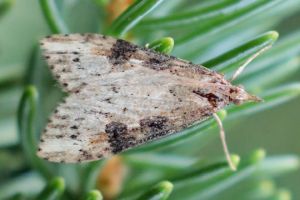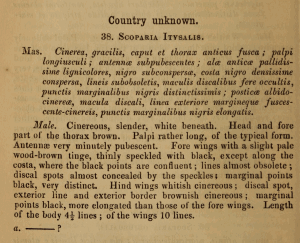Länder:

 +2Kontinente:EUAS
+2Kontinente:EUAS


 +2Kontinente:EUAS
+2Kontinente:EUASNeues Layout der Navigation (Beta Test)
1. Lebendfotos
1.1. Falter
1: Kanada, Yukon, Whitehorse, 7. August 2021 (Foto: in [iNaturalist] publizierter Fund von John Meikle; Format redaktionell angepasst [CC BY-NC])
2. Diagnose
2.1. Erstbeschreibung
1: Walker (1859: 828) [nach Copyright-freiem Scan auf www.biodiversitylibrary.org]
3. Weitere Informationen
3.1. Taxonomie
Nach den Barcoding-Studien von Mally & Nuss (2011) ist U. itysalis nahe verwandt mit Udea costalis, was ja auch zum ähnlichen Äußeren passt.
3.2. Faunistik
Kullberg & al. (2018/2019) wiesen die Art im europäischen Teil von Russland erstmals für Europa nach; der Fundort bei Bugrino (Бугрино) ist eine Siedlung auf der russischen Insel Kolgujew im Autonomen Kreis der Nenzen im Süden der Barentsee. Die Autoren erläutern: "A variable Holarctic species, which was described from North America, where it is widely distributed (Pohl et al. 2018). In Russia, this species was earlier recorded from Chukotka, Kamchatka and Magadan oblast (Sinev 2008). The first record from Europe."
(Autor: Erwin Rennwald)
3.3. Literatur
- Kullberg, J., Filippov, B. Yu., Spitsyn, V. M., Zubrij, N. A. & M. V. Kozlov (2018/2019) [Published online: 1 November 2018]: Moths and butterflies (Insecta: Lepidoptera) of the Russian Arctic islands in the Barents Sea. Faunistic notes on Lepidoptera collected from arctic Tundra in European Russia. — Polar Biology 42 (2): 335–346. [https://doi.org/10.1007/s00300-018-2425-z] [Zur Arbeit und zum PDF-Download auf link.springer.com].
- Mally, R. & M. Nuss (2011): Molecular and morphological phylogeny of European Udea moths (Insecta: Lepidoptera: Pyraloidea). — Arthropod Systematics & Phylogeny 69 (1): 55–71. [zur Arbeit und PDF-Download auf researchgate.net]
- Erstbeschreibung: Walker, F. (1859): List of the Specimens of Lepidopterous Insects in the Collection of the British Museum 19: 799-1036. London.




